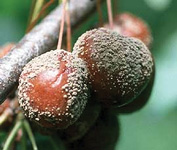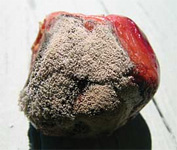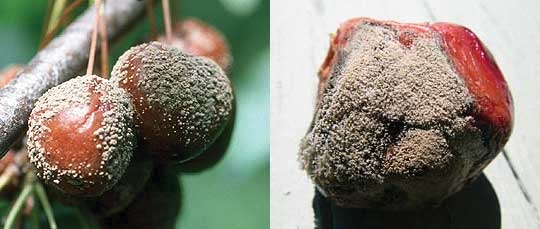(cont from last month)
Infection cycle of major fruit rotting fungi
Brown Rot
Infections can remain dormant and symptomless until fruit begin to ripen. Such infections are termed ‘latent’ infections.
Grey Mould
Botrytis rot of mature cherries may be mistaken for brown rot as the symptoms are very similar.
Fruit develop a firm, brown decay and become covered with light brown spores. The disease can develop at cold temperatures and has the ability to spread at harvest and in storage. This disease is often confused with brown rot in the field.

 The fungus overwinters in the soil and in plant debris; it becomes active under cool moist conditions.
The fungus overwinters in the soil and in plant debris; it becomes active under cool moist conditions.
- This disease has a very wide host range, including most fruits and many vegetables and ornamentals.
- The fungus can survive for many years in the soil without a host plant.
- Like Brown Rot, rots usually only develop in ripening fruit, although green fruit rots can occur.
- Unlike Brown Rot, flower infections are the major source of infection for pre and post harvest fruit rots.
- Similar to Brown Rot, Grey Mould infections require a minimum of four hours of surface wetness for spore germination. The optimum temperature for disease development is 18C to 21C. High night temperature and day time humidity also favour disease development.
- The fungus can over winter on infected trash (fruit, leaves, fruit stalks, twigs) as minute, hard bodies called sclerotes. It can also survive in the soil as fine filamentous threads (mycelia). Conidia spores emerge from sclerotes during spring.
Why do fruit rots develop?
For rots to develop there must be:
- Presence of inoculums (infectious material)
- Appropriate weather conditions for the development of the inoculums.
Other factors that impact on the severity of the problem include: •latent infections •dense tree canopies •fruit variety •nutrition •chemical control program.
Inoculum
A disease outbreak will not occur in the absence of inoculum.
Fungal spores, both within the canopy and on the orchard floor are the main source of inoculum. Inoculum in the tree canopy is the most important source of infectious material for initiating an infection.
Significant level of inoculum
The following information for Brown Rot in cherries was extracted from a USA extension pamphlet:
- 1–10 diseased fruits within a single tree canopy: medium risk of disease development the following season.
- 10–20 diseased fruits within a single tree canopy: high risk of disease development the following season.
Major sources of inoculums (See Tree Fruit Nov 2011)
Weather
Fungal spore germination requires a film of free water on the plant surface (rain, dew, mist fog).
If inoculum is present, Brown Rot and Grey Mould diseases will develop during wet seasons.
Prolonged wet weather during bloom and critical times during the growing season will create the conditions necessary for spore germination.
The length of wet periods required for blossom infection depends upon the temperature. Table 1 illustrates the length of wet period required for blossom and fruit infection to occur at various temperatures (See Tree Fruit Nov 2011).
Frost during flowering will create additional injury sites for fungal entry.
High humidity results in condensation of water on blossoms and fruits. Fungal spores are able to germinate in this water film. Disease development for both Brown Rot and Grey Mould requires high humidity (97% + RH).
Heavy rainfall events will wash protectant fungicides off plant surfaces while persistent rainfall will make it difficult to apply fungicides at key strategic times.
Excessive soil moisture has also been linked to increased incidence of Grey Mould infection. Strong winds and rain aid in fungal spore dispersal.
Latent infections
- Flowers, and green hard fruit can be infected.
- After entry, fungal growth is stopped due to the concentration of natural antifungal compounds within flowers and green fruit.
- Fungal growth resumes during fruit ripening.
- Aborted fruitlets (fruit drop) behave like ripening fruits.
Dense tree canopies
Dense tree canopies favour high humidity within the canopy, a condition which favours growth and development of fungal moulds. Dense canopies are often associated with: •high tree density •excessive number of limbs per tree •excessive vigour.
Netting, necessary for bird control, can also cause higher humidity within orchard blocks due to reduced air movement. Netting can also contribute to slower drying of orchard canopies following rain.
Variety
Although varieties differ in their susceptibility to fruit rots, differences in fruiting behaviour between varieties is probably the most important contributing factor.
Varieties which tend to bear fruits in tight clusters (Van, Lapins, Simone, Sweetheart) are more vulnerable to developing fruit rots than varieties with a more open fruiting behaviour (Regina).
For more information, see the November 2011 issue of Tree Fruit




















